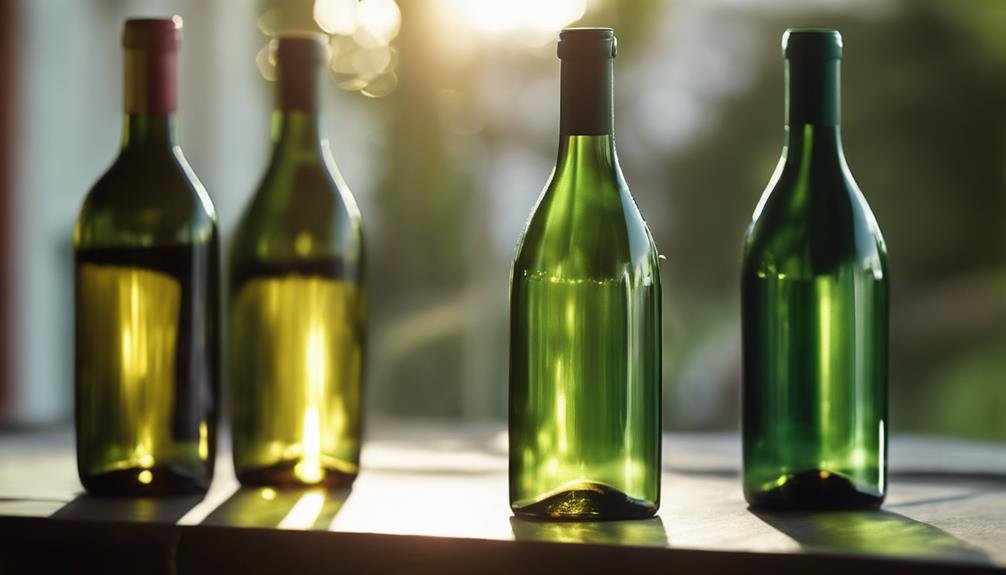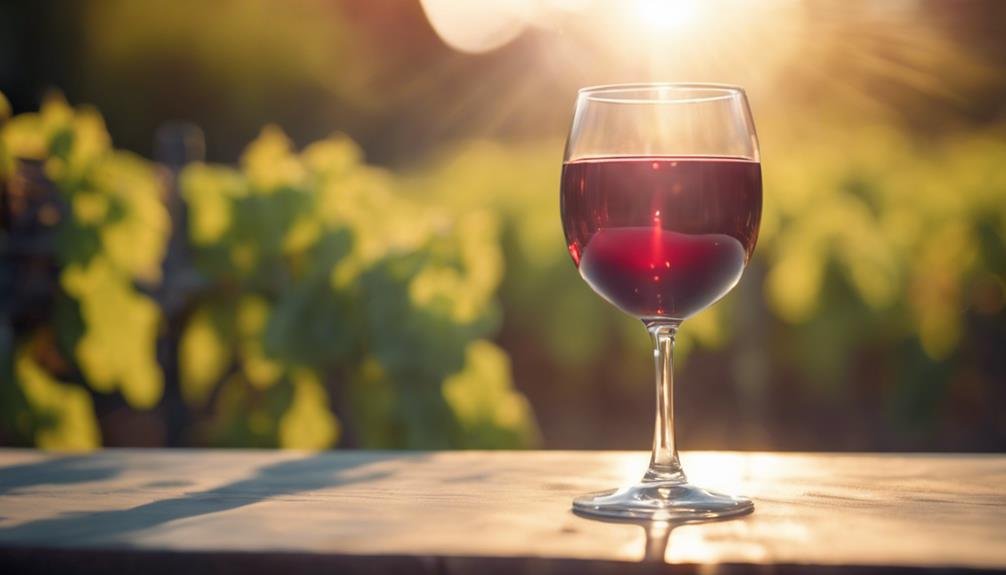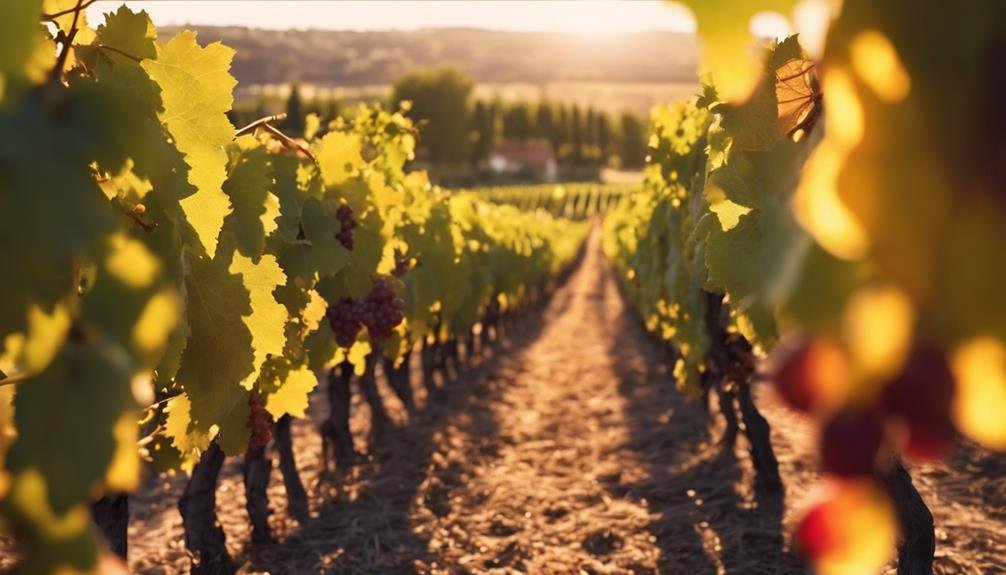Direct sunlight exposure poses risks to wine quality, altering aroma and taste due to UV rays triggering chemical reactions. Light struck wine often produces unwanted sulfur compounds affecting its flavor. Shield wine from sunlight to maintain quality, opting for amber or green glass bottles for UV protection. The choice of bottle color has a substantial impact on wine preservation, with amber offering the best defense. Implementing LED lighting can further safeguard wine from UV exposure risks. Strategic preservation methods and proper storage help preserve wine flavor and longevity effectively. Sunlight may subtly impact wine, influencing its taste, aroma, and overall quality over time.
Impact of Direct Sunlight Exposure
How does direct sunlight exposure affect the quality of wine, particularly in relation to light strike and aroma alterations?
Sunlight effects on wine can be detrimental, with light strike leading to aroma alteration. When exposed to sunlight, UV rays excite riboflavin and pantothenic acid in the wine, causing these molecules to react with amino acids and produce undesirable sulfur compounds.
Clear bottles are susceptible to wine damage after just 3 hours of sun exposure, while green bottles can be affected in as little as 18 hours. To mitigate these effects, opting for amber glass bottles provides almost complete protection from UV rays, while green glass offers moderate defense.
Understanding the impact of direct sunlight exposure is essential in preserving the aroma and quality of wine.
Influence of UV Rays on Wine
Direct sunlight exposure can have detrimental effects on wine quality, particularly through the influence of UV rays on the wine when discussing the Influence of UV Rays on Wine. UV rays are particularly harmful to wine, causing UV damage that can alter the taste and aroma.
To prevent UV damage and guarantee proper wine preservation, the following steps are vital:
- Shielding: Keep wine away from direct sunlight exposure to minimize UV damage.
- Storage: Opt for storing wine in locations that are shielded from UV rays to preserve its quality.
- Bottle Choice: Select wine stored in amber or green glass bottles over clear ones to provide effective UV protection.
Protecting wine from UV rays is essential for maintaining its integrity and flavor over time.
Bottle Color and UV Protection

The selection of bottle color plays a vital role in determining the level of protection wine receives against harmful UV rays. Glass color variations, such as amber, green, and clear, directly impact the wine's exposure to ultraviolet radiation effects.
Amber glass provides almost complete protection, shielding the wine from UV rays effectively. Green glass offers moderate protection due to its historical production ease, while clear glass provides minimal defense against light strike.
It is essential to take into account the bottle color when storing wine to minimize sunlight exposure and preserve its quality. Avoiding fluorescent lights and opting for amber or green glass bottles can help safeguard the wine from UV damage, ensuring its longevity and flavor integrity.
Wine-Saving Techniques
When considering wine-saving techniques, the choice of bottle color becomes a pivotal factor in safeguarding the wine from the damaging effects of sunlight exposure. Protective measures and storage solutions are essential to maintain wine quality.
Here are three key strategies:
- Opt for Amber Glass: Choose bottles with amber glass as it provides almost complete protection from UV rays, safeguarding the wine from light strike and maintaining its aroma.
- Utilize Green Glass: While not as effective as amber, green glass offers moderate protection against sunlight exposure, making it a better choice than clear glass for wine storage.
- Implement LED Lighting: Installing LED bulbs in storage areas eliminates UV exposure risks, ensuring the wine remains protected and its quality preserved over time.
Prolonging Wine Life and Flavor

Enhancing the longevity and flavor profile of wine involves implementing strategic preservation methods that mitigate the detrimental impact of sunlight exposure. Protective measures such as storing wine in amber or green glass bottles greatly reduce UV damage, preserving the wine's integrity.
LED bulbs offer an effective solution to prevent light strike and maintain the quality of stored wine. Proper storage solutions, like shielding wine from direct sunlight and avoiding exposure to non-LED lighting, play an important role in safeguarding the flavor and lifespan of wine.
Frequently Asked Questions
Can Artificial Light Sources Like Incandescent Bulbs Also Damage Wine?
Light sensitivity in wine quality is a concern. Incandescent bulbs emit minimal UV rays, posing negligible risk to wine. However, prolonged exposure may impact delicate wines. For best preservation, consider LED lighting and proper storage.
How Does Temperature Affect Wine Quality in Relation to Sunlight Exposure?
Temperature variation during sunlight exposure can impact wine quality greatly, affecting the fermentation process. Just as a delicate balance in nature is disrupted by sudden changes, wine's intricate flavors can be altered by fluctuating temperatures, influencing its overall character.
Are There Specific Regions in the World Where Sunlight Affects Wine Differently?
Different wine regions experience varied sunlight effects due to latitude. UV resistance technology in bottle color impacts wine quality. Understanding these factors aids in preserving wine integrity. Consider bottle color and storage methods for best UV protection.
Does the Angle of Sunlight Exposure Impact Wine Preservation in Storage?
The angle of sunlight exposure greatly influences wine preservation during storage. Correct orientation minimizes UV damage, preserving wine aging potential. Utilize UV protection methods, such as amber or green glass bottles, to shield wine from harmful sunlight effects.
Can Using Tinted Wine Glasses Provide Additional Protection Against UV Rays?
Using tinted wine glasses, particularly amber or green, can enhance UV protection for wine, safeguarding its quality. Glass color plays a pivotal role in shielding wine from harmful rays, ultimately contributing to preserving its flavor.
Conclusion
To sum up, the impact of sunlight on wine quality is a complex issue that requires careful consideration.
While bottle color plays an essential role in protecting wine from harmful UV rays, some may argue that other factors, such as storage conditions and temperature control, are equally important in preserving wine integrity.
By implementing a combination of protective measures, including using amber or green glass bottles and storing wine in a cool, dark environment, wine enthusiasts can safeguard their favorite bottles and enjoy their flavors for longer periods.
